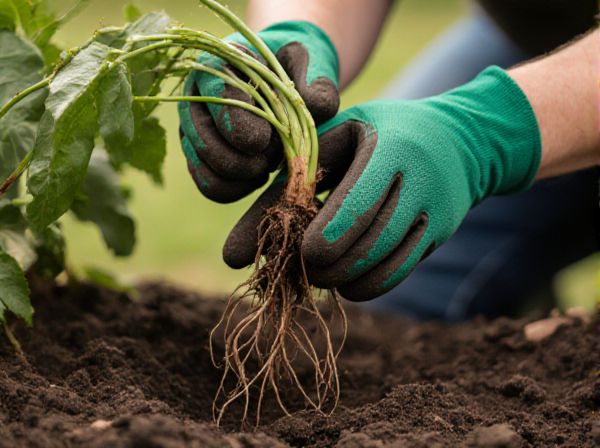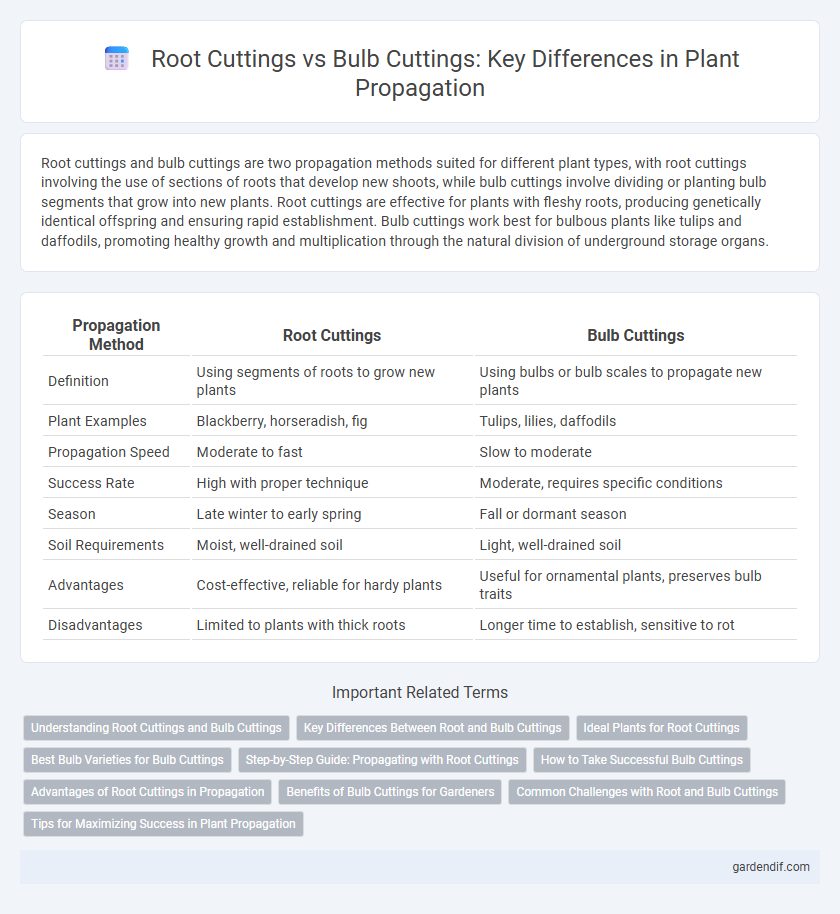
Root cuttings vs bulb cuttings Illustration
Root cuttings and bulb cuttings are two propagation methods suited for different plant types, with root cuttings involving the use of sections of roots that develop new shoots, while bulb cuttings involve dividing or planting bulb segments that grow into new plants. Root cuttings are effective for plants with fleshy roots, producing genetically identical offspring and ensuring rapid establishment. Bulb cuttings work best for bulbous plants like tulips and daffodils, promoting healthy growth and multiplication through the natural division of underground storage organs.
Table of Comparison
| Propagation Method | Root Cuttings | Bulb Cuttings |
|---|---|---|
| Definition | Using segments of roots to grow new plants | Using bulbs or bulb scales to propagate new plants |
| Plant Examples | Blackberry, horseradish, fig | Tulips, lilies, daffodils |
| Propagation Speed | Moderate to fast | Slow to moderate |
| Success Rate | High with proper technique | Moderate, requires specific conditions |
| Season | Late winter to early spring | Fall or dormant season |
| Soil Requirements | Moist, well-drained soil | Light, well-drained soil |
| Advantages | Cost-effective, reliable for hardy plants | Useful for ornamental plants, preserves bulb traits |
| Disadvantages | Limited to plants with thick roots | Longer time to establish, sensitive to rot |
Understanding Root Cuttings and Bulb Cuttings
Root cuttings involve using sections of healthy roots to produce new plants, commonly applied in species like horseradish and black currant; these cuttings contain stored nutrients essential for initial growth. Bulb cuttings, often used in plants such as lilies and tulips, rely on dividing or cutting bulbs that contain embryonic shoots and nutrient reserves necessary for development. Both methods exploit the plant's natural ability to regenerate from specialized organs, with root cuttings typically promoting fibrous root development and bulb cuttings facilitating shoot and flower formation.
Key Differences Between Root and Bulb Cuttings
Root cuttings involve using sections of roots to propagate plants, promoting new shoots from dormant buds, while bulb cuttings use bulb scales or daughter bulbs to generate clones of the parent plant. Root cuttings typically require dormant or semi-dormant periods and produce adventitious shoots, whereas bulb cuttings can be separated and planted during the growing season for quicker development. Key differences include the plant types suited for each method, with root cuttings often used for woody or herbaceous perennials and bulb cuttings primarily for geophytic or bulbous plants like tulips and lilies.
Ideal Plants for Root Cuttings
Root cuttings are ideal for plants with strong, fibrous root systems such as horseradish, currants, and blackberries, allowing for efficient propagation of woody shrubs and perennials. These plants regenerate well from root sections taken during dormancy, ensuring vigorous new growth and maintaining genetic consistency. Root cuttings work best with species that naturally produce thick, fleshy roots capable of sprouting shoots and roots simultaneously.
Best Bulb Varieties for Bulb Cuttings
Best bulb varieties for bulb cuttings include tulips, daffodils, and lilies due to their robust scales and ability to produce offsets quickly. These bulbs exhibit high success rates in propagation as their structure allows for easy separation and growth into new plants. Selecting disease-free, firm bulbs enhances rooting and overall plant vigor when propagating through bulb cuttings.
Step-by-Step Guide: Propagating with Root Cuttings
Collect healthy root segments 3-6 inches long during dormancy for optimal propagation success. Place root cuttings horizontally in a well-draining medium, covering lightly to maintain moisture while allowing air circulation. Maintain consistent warmth around 65-75degF and indirect light to encourage new shoot and root development within a few weeks.
How to Take Successful Bulb Cuttings
To take successful bulb cuttings, select healthy, mature bulbs free from disease or damage, then carefully separate the offsets from the parent bulb. Plant the offsets in well-draining soil at a depth twice the bulb's size, ensuring consistent moisture without waterlogging to encourage root development. Maintain a warm environment around 65-75degF (18-24degC) and provide indirect sunlight to promote strong growth before transplanting.
Advantages of Root Cuttings in Propagation
Root cuttings offer robust advantages in propagation by ensuring genetic consistency and promoting vigorous plant development due to their established nutrient networks. They provide a higher success rate in rooting compared to bulb cuttings, especially in woody plants and perennials, allowing faster establishment and growth. Root cuttings also enable propagation during dormant seasons, expanding opportunities beyond the limited timeframes typical for bulb cuttings.
Benefits of Bulb Cuttings for Gardeners
Bulb cuttings offer gardeners faster establishment and greater disease resistance compared to root cuttings, leading to healthier plants and quicker blooms. These cuttings typically have higher success rates due to the energy reserves stored in bulbs, enabling vigorous growth and robust root systems. Gardeners benefit from uniform plant development and enhanced propagation efficiency when using bulb cuttings.
Common Challenges with Root and Bulb Cuttings
Root cuttings often face challenges such as rot and desiccation due to improper moisture levels, while bulb cuttings are prone to fungal infections and slow sprouting. Both methods require precise temperature control and sterile conditions to prevent disease and ensure successful propagation. Monitoring environmental factors like humidity and soil composition is critical in overcoming these common obstacles.
Tips for Maximizing Success in Plant Propagation
Root cuttings require coarse, well-draining soil and consistent moisture to encourage strong, healthy root development, while bulb cuttings benefit from planting in nutrient-rich, slightly sandy soil to prevent rot and promote bulb enlargement. Maintaining optimal temperature ranges--typically between 65-75degF (18-24degC)--and providing indirect light enhances cellular activity and speeds up rooting in both propagation methods. Regular monitoring for pests and fungal infections, combined with the use of rooting hormones, can significantly increase the success rate of plant propagation through root and bulb cuttings.
Root cuttings vs bulb cuttings Infographic

 gardendif.com
gardendif.com